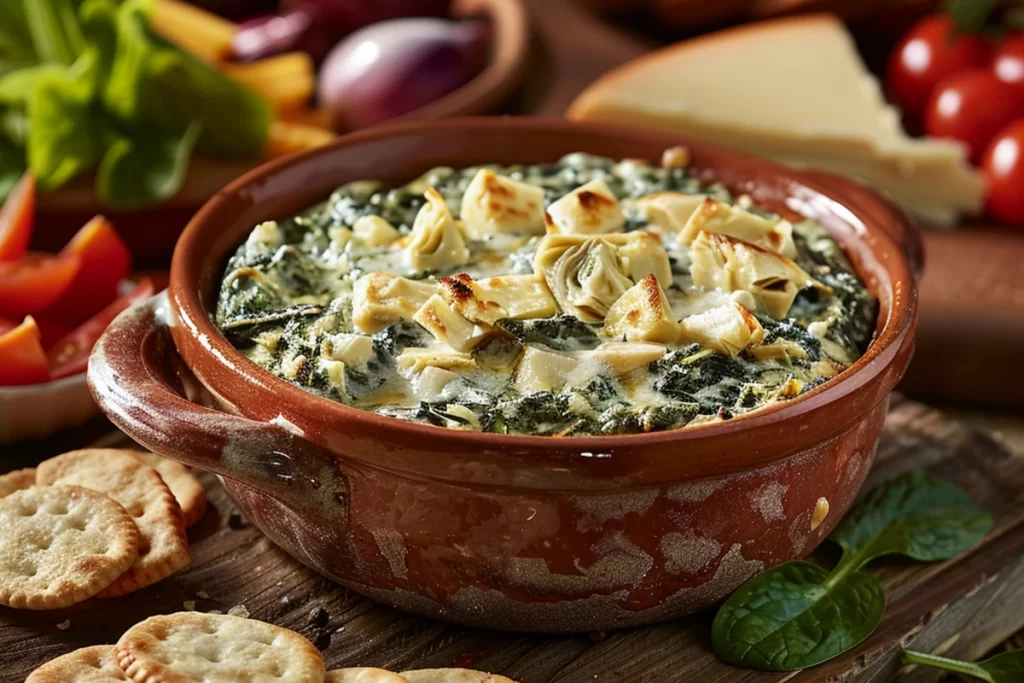Table of Contents
Dive into the world of gourmet dips with this ultimate guide to Alton Browns spinach artichoke dip – your ticket to an unforgettable culinary experience.
A Culinary Adventure with Alton Browns Spinach Artichoke Dip
Embark on a culinary journey like no other with Alton Brown’s iconic spinach artichoke dip. Alton brown spinach artichoke dip is more than just a party favorite; it’s a testament to the blend of science, creativity, and culinary expertise that Alton Brown is renowned for. In this guide, we’ll take you through the origins, ingredients, and step-by-step instructions to recreate this masterpiece at home, ensuring each scoop is packed with flavor and history.
The Inspiration Behind the Recipe: Unveiling the Culinary Genius of Alton Brown
Alton Brown, a name synonymous with culinary innovation, brings a unique blend of science and art to the kitchen. His approach to cooking is about understanding the ‘why’ behind the ‘how,’ making his recipes not just meals but educational experiences.
– A Brief Biography of Alton Brown
Born in Los Angeles, California, Brown has been a formidable presence in the culinary world, with a career spanning television, books, and live performances. His curiosity and desire to educate others about food have made him a household name.
– The Role of Creativity in Culinary Arts
AltonBrowns spinach artichoke dip is a prime example of how creativity can transform simple ingredients into a culinary delight. This dish exemplifies how experimenting with textures and flavors can produce a dip that stands out in the vast sea of appetizers.
Alton Brown Spinach Artichoke Dip: Step-by-Step Guide
Essential ingredients serve as the cornerstone of culinary creation, forming the foundation upon which all flavorful dishes are built. These building blocks of flavor not only impart depth and complexity to recipes but also define the character and soul of the cuisine.
Understanding and mastering the use of these essential ingredients can transform the simplest dishes into a memorable feast. This guide explores the crucial elements that should have a place in every kitchen, ready to elevate your cooking to new heights.
Salt: The Flavor Enhancer
Salt is the quintessential flavor enhancer, capable of bringing out the intrinsic tastes of ingredients without overwhelming them. It’s a fundamental seasoning in cooking, crucial for balancing and deepening flavors. Whether it’s finishing salt sprinkled over a dish just before serving or kosher salt used during the cooking process, salt is indispensable in the culinary world.
Fats: The Flavor Carriers
Fats, including oils, butter, and lard, are essential for cooking and baking. They not only add richness and moisture but also carry flavors, helping to distribute them throughout the dish. Olive oil, with its fruity notes, is perfect for dressings and Mediterranean dishes, while butter adds a creamy texture and nutty flavor to sauces and baked goods.
Acids: The Brighteners
Acids, such as vinegar and citrus juice, add a bright, tangy contrast to the richness of fats and the depth of savory flavors. They can lift a dish, providing balance and complexity. Lemon juice, for instance, can freshen up a seafood dish, while balsamic vinegar can add a sweet and sour element to salads.
Sweeteners: The Balance to Acidity and Heat
Sweeteners like sugar, honey, and syrups play a critical role in balancing flavors, especially acidity and heat. They can round out the edges of a dish, adding depth and a contrasting flavor profile. Maple syrup, for example, can add a complex sweetness to savory dishes or enhance the flavors in baked goods.
Herbs and Spices: The Aromatic Flavor Boosters
Herbs and spices are the magic wands of the kitchen, capable of transforming a dish with just a pinch or a handful. They add aroma, color, and nuanced flavors, whether used fresh or dried. Basil, cilantro, cumin, and cinnamon are just a few examples that can dramatically change the flavor profile of a dish.
Umami Boosters: Depth and Complexity
Ingredients that boost umami, such as tomatoes, mushrooms, soy sauce, and Parmesan cheese, add a savory depth and complexity to dishes. Umami, known as the fifth taste, enhances the overall flavor sensation, making dishes more satisfying and mouthwatering.
Alton Brown’s approach to cooking combines a scientific understanding of ingredients with a playful exploration of flavors, making even classic recipes uniquely his own. His version of Spinach Artichoke Dip is no exception. While I can’t provide an exact recipe from Alton Brown himself due to copyright restrictions, I can guide you through a similar recipe inspired by his culinary philosophy. This step-by-step guide will help you create a delicious Spinach Artichoke Dip that embodies the essence of Alton Brown’s approach to cooking.
Ingredients (Alton Brown Spinach Artichoke Dip)
- 1 lb (about 450g) of fresh spinach, cleaned and trimmed
- 1 can (14 ounces) of artichoke hearts, drained and chopped
- 1 cup of sour cream
- 1 cup of cream cheese, softened
- 1 cup of grated Parmesan cheese
- 1 tablespoon of minced garlic
- Salt and pepper to taste
- A pinch of nutmeg (optional)
- Olive oil (for sautéing)
- 1/2 cup of grated mozzarella cheese (for topping)
More recipes: Pineapple Cloud Cake
Equipment (Alton Brown Spinach Artichoke Dip)
- A large skillet
- A mixing bowl
- A baking dish
- A spatula
Step-by-Step Guide to making Alton Brown Spinach Artichoke Dip
Preheat the Oven
Start by preheating your oven to 375°F (190°C), ensuring it’s ready for baking the dip.
Prepare the Spinach
- Heat a splash of olive oil in a large skillet over medium heat.
- Add the spinach to the skillet in batches, sautéing until wilted. This usually takes 1-2 minutes per batch.
- Once all the spinach is wilted, transfer it to a colander and press out as much liquid as possible.
Mix the Dip Base
- In a large mixing bowl, combine the sour cream, cream cheese, and Parmesan cheese. Mix until well blended.
- Stir in the minced garlic, and season with salt, pepper, and a pinch of nutmeg if using. This adds a subtle depth to the flavor profile.
Combine Ingredients
- Chop the wilted spinach coarsely and add it to the mixture in the bowl.
- Add the chopped artichoke hearts to the bowl and fold all the ingredients together until evenly mixed.
Bake the Dip
- Transfer the mixture to a baking dish, spreading it evenly.
- Sprinkle the grated mozzarella cheese over the top for a gooey, golden crust.
- Bake in the preheated oven for about 20-25 minutes, or until the dip is bubbling and the cheese on top has turned golden brown.
Serving
Let the dip cool for a few minutes before serving. This dish pairs wonderfully with tortilla chips, sliced baguette, or fresh vegetables for dipping. The creamy, savory flavors of the spinach and artichokes, combined with the rich, melty cheese, make this dip a crowd-pleaser at any gathering.
Customizing your Spinach Artichoke Dip allows you to tailor the flavors and textures to your preferences, making this classic appetizer uniquely yours. Drawing inspiration from Alton Brown’s experimental approach to cooking, consider these variations as a way to explore and enhance the basic recipe. Each modification introduces new dimensions of flavor or texture, offering a personalized experience for you and your guests.
1. Cheese Variations (Alton Brown Spinach Artichoke Dip)
- Swap Out Parmesan: Instead of Parmesan, try using aged Gouda or smoked cheddar for a deeper, smokier flavor.
- Add Creaminess: Incorporate a dollop of mascarpone or ricotta cheese into the mix for extra creaminess.
2. Protein Boost (Alton Brown Spinach Artichoke Dip)
- Crab Meat: Fold in lump crab meat for a luxurious twist. The sweetness of the crab pairs beautifully with the creamy base.
- Bacon Bits: Add crispy bacon bits for a salty, smoky crunch that complements the creamy spinach and artichoke hearts.
3. Spice It Up (Alton Brown Spinach Artichoke Dip)
- Red Pepper Flakes: Sprinkle red pepper flakes into the mix for a gentle heat.
- Jalapeños: Incorporate diced jalapeños for a spicy kick. Adjust the amount based on your heat preference.
4. Extra Veggies (Alton Brown Spinach Artichoke Dip)
- Sun-Dried Tomatoes: Add chopped sun-dried tomatoes for a tangy sweetness and a pop of color.
- Sautéed Mushrooms: Mix in sautéed mushrooms for an earthy flavor and additional umami.
5. Herb Freshness (Alton Brown Spinach Artichoke Dip)
- Fresh Dill: Mix in chopped fresh dill for a refreshing twist. Dill pairs well with creamy dishes.
- Basil and Oregano: Add chopped basil and oregano for an Italian-inspired version.
6. Tangy Accents (Alton Brown Spinach Artichoke Dip)
- Lemon Zest: Grate lemon zest into the dip for a bright, citrusy note.
- Capers: Stir in capers for a briny, tangy element that cuts through the richness of the dip.
7. Global Flavors (Alton Brown Spinach Artichoke Dip)
- Greek Style: Use feta cheese and mix in some olives and roasted red peppers for a Mediterranean variation.
- Mexican Twist: Add a layer of guacamole beneath the dip and top with queso fresco and cilantro for a dip that nods to Mexican flavors.
8. Crunch Factor (Alton Brown Spinach Artichoke Dip)
- Toasted Pine Nuts: Sprinkle toasted pine nuts on top before serving for added crunch and nuttiness.
- Panko Topping: Mix panko breadcrumbs with a little melted butter and Parmesan, sprinkle on top, and broil for a few minutes until golden for a crispy crust.
Serving Suggestions (Alton Brown Spinach Artichoke Dip)
Experiment with different serving vessels and accompaniments to match your dip’s flavor profile. For a Mediterranean spin, pita chips and cucumber slices make great dippers. For a heartier option, serve alongside sliced, toasted baguette or artisanal crackers.
Pairing Suggestions: Complementing Flavors
Pairing the right flavors can elevate a simple meal to an exquisite culinary experience. When it comes to serving Alton Brown Spinach Artichoke Dip or any other flavorful dish, selecting complementary pairings is crucial for enhancing and balancing the overall taste. Inspired by Alton Brown’s approach to thoughtful and inventive cooking, here are some pairing suggestions designed to harmonize with the rich and creamy flavors of a Spinach Artichoke Dip, catering to a variety of preferences and occasions.
Beverages
- Crisp White Wines: A glass of Sauvignon Blanc or Pinot Grigio, known for their crisp acidity, can cut through the richness of the dip, cleansing the palate.
- Light to Medium-bodied Reds: For red wine lovers, opt for a light to medium-bodied red, such as Pinot Noir or Grenache, which won’t overpower the flavors of the dip.
- Craft Beers: A light, hoppy beer like a Pilsner or an American Pale Ale offers a refreshing contrast to the creamy dip.
- Sparkling Water with Citrus: For a non-alcoholic option, serve sparkling water with a squeeze of lemon or lime to add a refreshing zest that complements the dip.
Breads and Crackers
- Crusty Baguette: Slices of a freshly baked baguette, lightly toasted, provide a crunchy texture and a neutral taste that pairs well with the dip.
- Pita Chips or Bread: Lightly seasoned and baked pita chips or soft pita bread offer a delightful texture and subtle flavor that doesn’t compete with the dip.
- Artisan Crackers: Choose crackers with herbs or seeds to add a layer of texture and flavor that enhances the dip without overwhelming it.
Fresh Vegetables
- Crisp Veggies: Serve an array of fresh vegetables like carrot sticks, cucumber slices, bell pepper strips, and cherry tomatoes for a healthy, crunchy contrast to the creamy dip.
- Endive Leaves: The slight bitterness of endive leaves pairs beautifully with the richness of the dip, offering a unique vessel for serving.
Fruits
- Apples and Pears: Slices of crisp apples or pears can add a sweet and tart element, offering a refreshing balance to the savory dip.
- Grapes: A bunch of fresh grapes, either red or green, provides a juicy, sweet contrast that complements the creamy and savory flavors.
Meats and Cheeses
- Charcuterie Board: A selection of cured meats like salami, prosciutto, and capicola alongside the dip can create a decadent and satisfying pairing.
- Assorted Cheeses: Offer a variety of cheeses, from sharp cheddar to creamy brie, to complement the dip’s flavor profile. This allows guests to explore different taste combinations.
The Science of Flavor: Understanding What Makes It Special
The science of flavor is a fascinating intersection of chemistry, biology, and psychology, delving into how and why certain tastes and aromas appeal to our senses. Flavor is not just a simple sensory experience but a complex perception that combines taste, smell, and the tactile sensations within our mouth. Understanding the scientific principles behind flavor can greatly enhance our appreciation and creation of culinary delights.
Taste: The Foundation of Flavor
Taste is detected by taste buds on our tongue, which can identify five basic tastes: sweet, sour, salty, bitter, and umami. These tastes act as the building blocks of flavor, providing the initial signals to our brain.
- Sweet signals energy and calories.
- Sour often indicates acidity, which can be a sign of freshness or spoilage.
- Salty is essential for our body’s fluid balance.
- Bitter can be a warning of toxins or, in small amounts, add complexity to food.
- Umami, discovered in the early 20th century, denotes the presence of amino acids (like glutamate) and signifies protein-rich foods.
Aroma: The Depth of Flavor
While taste lays the foundation, the aroma contributes to the depth and complexity of flavor. Aroma compounds are detected by the olfactory receptors in the nose. When food is chewed, volatile compounds are released and travel to the olfactory epithelium, a process known as retro nasal olfaction. This is why flavor can change or intensify when food is eaten, as opposed to merely being smelled.
Mouthfeel: The Physical Sensation
The tactile sensations, or mouthfeel, of food also play a critical role in our perception of flavor. This includes the texture, temperature, and astringency of food. For example, the creaminess of ice cream, the crunch of a crisp apple, or the heat of a spicy pepper all contribute to the overall flavor experience.
The Role of Psychology and Memory
Flavor preferences are not solely determined by biological factors; they are also influenced by psychological and cultural aspects. Memory plays a significant role in flavor perception. Positive or negative associations with certain foods can influence how we perceive their flavors. Cultural background also affects flavor preferences, with certain cuisines favoring specific combinations of tastes and aromas.
The Maillard Reaction: A Flavorful Reaction
One of the most important chemical reactions in cooking is the Maillard reaction, which occurs when proteins and sugars in food react under heat. This reaction is responsible for the browned, complex flavors in cooked meats, roasted coffee, and toasted bread. Understanding and controlling this reaction can significantly impact the flavor of cooked foods.
FAQs (Alton Brown Spinach Artichoke Dip)
Too Salty Dish?
Add more base ingredients, a touch of acid, or a bit of sweetness to dilute the saltiness.
Fluffy Rice Secret?
Use the correct water-to-rice ratio, rinse rice, boil then simmer, and let sit covered after cooking.
Dense Baked Goods?
Avoid overmixing, measure ingredients accurately, and check leavening agents are fresh.
Enhance Dish Flavor?
Use fresh ingredients, layer herbs and spices, and balance sweet, salty, sour, bitter, and umami tastes.
5. Chopping vs. Dicing?
Chopping is less precise; dicing aims for uniform pieces.
Prevent Pasta Sticking?
Use plenty of boiling water, stir early on, and avoid oil in the water.
Store Herbs Fresh?
Soft herbs in water, hard herbs in a damp towel in the fridge.
Conclusion: Embracing the Joy of Cooking
The journey through Alton Brown Spinach Artichoke Dip is not just a lesson in crafting a delicious appetizer; it’s a deeper dive into the joy and art of cooking itself. This dish, with its rich layers of flavor and comforting texture, is a testament to how simple ingredients can be elevated into something extraordinary through culinary skill and creativity.




